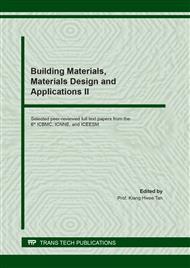p.87
p.99
p.111
p.119
p.129
p.141
p.149
p.157
p.165
Improvement of the Shear Strength Parameters of a Granular Volcanic Soil Using Type I Portland Cement
Abstract:
The purpose of this research is to improve the parameters of shear strength in granular volcanic soil, by adding a percentage of Portland type I cement. The first step for this research was to classify the soil through a Granulometry test, according to the Unified Soil Classification System (USCS), the result was considered as a poorly graded sand with gravel also considered by The American Association of State Highway and Transportation Officials (AASHTO) as “A-1-b”. In addition, the compaction curve of the volcanic soil has a Maximum Dry Density (MDD) of 1.21 kg/cm2 and an optimum moisture content of 17.8%. Also, the friction angle of 33.5° and a cohesion of 0 kg/cm2, and the results of the Direct Shear Test indicate the Residual Stresses of 0.63, 1.34 and 2.65 kg/cm2 according to the Normal Stresses 1, 2 and 4 kg/cm2, respectively. The second step was to apply a Modified Proctor Test as following: one sample for natural soil and four samples adding 3%, 5%, 7% and 9% of cement. Finally, applied the Direct Shear Test: one sample for natural soil and three samples adding 3%, 5%, and 7% of cement after 7 days of curing, then three more samples are taken adding 3, 5% and 7% of cement at 14 days of curing. The results of the Modified Proctor Test of the volcanic soil with the addition of 5% cement has a maximum peak of a Maximum Dry Density of 1.33 kg/cm2 and with an Optimal Moisture Content of 22.7%, improved the MDD by 10% in regard to the natural soil. And the results of the Direct Shear Test shown in each sample an increase from 14.6% to 79.1% in the friction angle in comparison with the natural soil from 25.8% to 161.5% in shear strength. Likewise, the behavior of the volumetric deformation is shown, presenting a greater contraction when a normal stress of 1 kg/cm2 is applied and a greater expansion when a normal stress of 4 kg/cm2 is applied. Also, the volcanic soil at 7 days of curing with 7% cement addition increases its resistance by 67.34% and the volumetric variation decreases by 50% and the volcanic soil at 14 days of curing with 5% addition of cement increases its resistance by 103.40% and the volumetric variation decreases by 25%.
Info:
Periodical:
Pages:
165-172
Citation:
Online since:
August 2021
Keywords:
Price:
Сopyright:
© 2021 Trans Tech Publications Ltd. All Rights Reserved
Share:
Citation:


